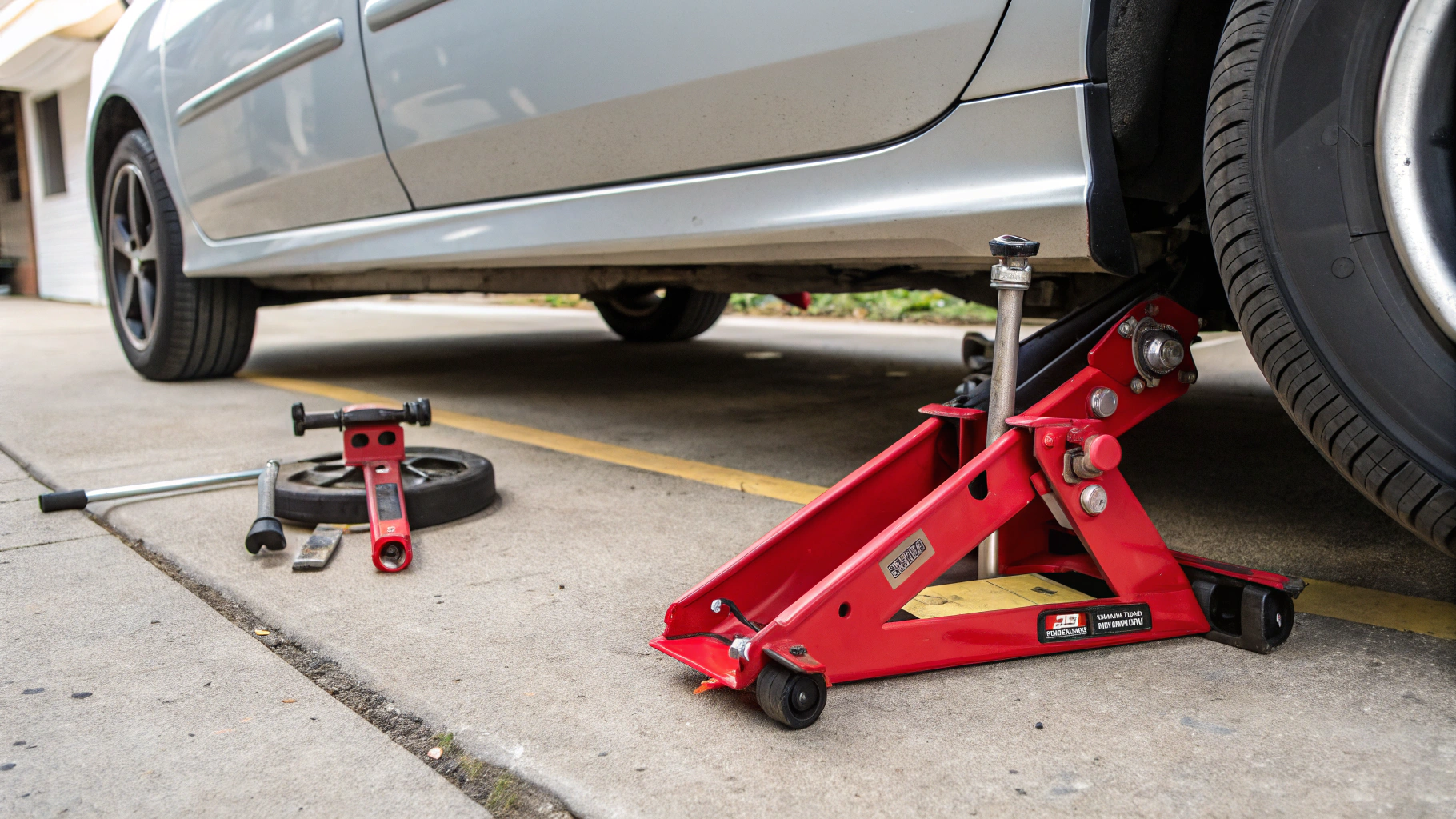Floor Jack Safety Guide: Must-Know Tips for Safe Lifting
Table of Contents
Understanding the fundamentals of floor jacks is crucial for anyone involved in vehicle maintenance. This floor jack safety guide will equip you with the knowledge needed to lift and support your vehicle safely and efficiently.
By mastering the safe use of floor jacks, you can perform necessary vehicle maintenance without compromising your safety. This guide will take you through every essential step to ensure a secure working environment.
How to Use the Floor Jack Safely | Step-by-step for DIY beginners
Using a floor jack correctly is the first step toward safe vehicle maintenance. Follow these essential steps to ensure your safety:
Prepare Your Workspace
Before using a floor jack, ensure you’re working on a flat, level surface. Concrete garage floors are ideal, while asphalt, dirt, or gravel surfaces should be avoided as they can shift under weight. Clear the area of any debris or obstacles that might interfere with your work.
Position the Vehicle
Put your vehicle in “Park” (or in gear for manual transmissions) and engage the parking brake. For extra security, place wheel chocks on the wheels that will remain on the ground – if you’re lifting the front, chock the rear wheels and vice versa.
Locate Proper Lifting Points
Consult your vehicle’s owner manual to identify the manufacturer-recommended jacking points. These are reinforced areas designed to safely support the vehicle’s weight. Using incorrect lifting points can damage your car’s frame or body panels and create dangerous instability.
Proper Jack Positioning
Place the floor jack precisely under the lifting point. The jack’s saddle (lifting pad) should make full contact with the jacking point. Before lifting, double-check your positioning to ensure proper alignment.
Lift Gradually and Steadily
Pump the jack handle with smooth, controlled motions. Lift the vehicle just high enough to perform your intended work or to place jack stands underneath. Avoid jerky movements that could destabilize the vehicle. Never lift higher than necessary.
Jack Stand Placement Explained | Secure vehicle support basics
A floor jack alone is not sufficient for supporting a vehicle during maintenance. Jack stands are essential safety equipment that provide stable support.
Never Skip the Jack Stands
Floor jacks are designed for lifting, not long-term support. They can gradually lose pressure and lower unexpectedly. Never work under a vehicle supported only by a floor jack – this is perhaps the most important floor jack safety rule.
Select Appropriate Jack Stands
Use jack stands with a weight rating that exceeds your vehicle’s weight. Most passenger cars require stands rated for at least 2 tons, while heavier vehicles like trucks and SUVs may require 3-ton or higher capacity stands.
Correct Placement Points
Position jack stands under the vehicle’s frame rails or other manufacturer-recommended support points. These are typically located behind or in front of the jacking points and are specially reinforced to support the vehicle’s weight safely.
Equal Height and Stability
Adjust both jack stands to equal heights before placing them under the vehicle. Once positioned, lower the vehicle slowly onto the stands, ensuring they’re securely seated and the vehicle is level and stable.
Test Vehicle Stability
Before getting under the vehicle, test its stability by applying firm pressure from various angles. Rock the vehicle slightly to ensure it’s securely supported by the jack stands. If you detect any movement or instability, raise the vehicle again and reposition the stands.
Avoiding Common Floor Jack Mistakes | Best lifting practices and tips
Even experienced mechanics sometimes make safety mistakes. Being aware of common errors can help you avoid potentially dangerous situations.
Overloading the Jack
Never exceed the rated capacity of your floor jack or jack stands. This information is typically stamped on the equipment. Using a jack for a vehicle that exceeds its weight rating can lead to catastrophic failure.
Neglecting Regular Maintenance
Inspect your floor jack before each use for signs of damage, fluid leaks, or loose components. Keep moving parts lubricated according to the manufacturer’s recommendations. A well-maintained jack operates more smoothly and safely.
Improper Storage
Store your floor jack with the lifting arm fully lowered to prevent seal damage and fluid leakage. Keep it in a clean, dry place away from extreme temperatures. Proper storage extends the life and reliability of your equipment.
Forgetting Safety Backups
Even with jack stands in place, consider using additional safety measures. Placing the removed wheel under the vehicle’s frame can provide an extra layer of protection in case of jack stand failure.
Working on Uneven Surfaces
Always ensure you’re working on a flat, hard, level surface. Uneven or soft surfaces can cause the jack or stands to tilt or sink, creating an extremely dangerous situation.
Floor jack safety isn’t just about following procedures—it’s about developing a safety-first mindset. Before beginning any maintenance task that requires lifting your vehicle, take a moment to assess your setup. Ask yourself: Is the vehicle properly positioned? Are the jack and stands correctly placed? Have I taken all necessary precautions? For more on effective maintenance strategies, check out this guide on synthetic oil changes.
By following this floor jack safety guide and being methodical in your approach, you can confidently perform vehicle maintenance while minimizing risks. Remember that no repair or maintenance task is worth risking your safety—when in doubt, consult a professional mechanic. With proper knowledge and careful attention to safety details, you can successfully complete many automotive tasks on your own.
Shop Related Products:
- Find Floor jacks on Amazon
- Find Jack stands on Amazon
- Find Wheel chocks on Amazon
- Find Creeper on Amazon
- Find Mechanic gloves on Amazon
As an Amazon Associate we earn from qualifying purchases.
This floor jack safety guide provides vital information for safely conducting vehicle maintenance. Always prioritize safety and awareness to prevent accidents during your tasks.
Whether you’re a seasoned professional or a DIY enthusiast, understanding and applying the principles of this guide can significantly enhance your safety measures when using a floor jack.
Frequently Asked Questions
How do I use a floor jack safely?
Position the jack under the car’s designated lift points and raise it steadily. Ensure you’re working on a level surface, engage the parking brake, and use wheel chocks. Lift the vehicle just high enough to perform your work or place jack stands underneath. Never work under a vehicle supported only by a floor jack.
Where do I place jack stands?
Jack stands should be placed under strong, manufacturer-recommended support points. These are typically located on the vehicle’s frame rails or other reinforced areas. Consult your owner’s manual for the exact locations. Ensure both jack stands are adjusted to equal heights and test the vehicle’s stability before working underneath it.
Can I leave a car on a floor jack?
No, always use jack stands to support the vehicle. Floor jacks are designed for lifting, not long-term support. They can gradually lose pressure and lower unexpectedly, creating an extremely dangerous situation. Never work under a vehicle supported only by a floor jack, and never leave a vehicle unattended while it’s supported only by a jack.



